Friday, May 6, 2011
Logic Fail of the Day
Pastor Stephen Bishop posted on his church's facebook (now either down or private):
“Well, yesterday's sermon was a big hit! We had a mass execution of feeder fish that I pulled out of a fish tank and then threw all over the floor. The kids were in shock and then started to pic[sic] them up and put them back into the fish tank. Obviously, most of them died in the effort...the point however was made that they cared more about .15 cent feeder fish then[sic] they do about their friends dying w/o Christ.”
This gets posted on Reddit, and sparks an interesting line of insane justifications from the holy man himself, including:
"The lesson was not in making things suffer or allowing things to suffer. The point of the lesson was that we shouldn't want individuals to suffer in hell for all of eternity. That we need to act quickly because none of us are promised tomorrow and that we only have this moment to make an eternal impact on the lives of those we love."
Yes, because killing things totally illustrates that.
"I got [these methods] from someone else and used them because it was a GREAT illustration that I believed would and infact[sic] did have a deep and powerfully positive impact for our youth and their relationship with Jesus. Again positive. Again, are you saying fish have souls, because that obviously is not what I believe."
Not having a soul = totally disposable and just fine to callously discard.
"First of all, I did not equate the spiritual value of the fish to their monetary value. Fish have no spiritual value, but they do have nutritional value in that fish are food. They were given to us to be eaten and to be eaten by other animals. We are to be concerned yes for all living things but more so for the souls of mankind. I read that Jesus taught this same lesson to the disciples when they just left their boats, nets, and FISH to go and follow him and become fishers of men. It was not a message of fear for Jesus nor was it a message of fear for me. It was a message of love...love for all of mankind and the desperate need to reach everyone with his love before it is too late."
Love!
"I removed the post and opened a thread of response here because there ARE CHILDREN who view our church's FB and they don't need to see all of the hate postings and cussing that is being sent to me. I[sic] not unsure of my methods and I am not the first individual to have used this illustration. I received it from Michael Rowan, who is a world renown[sic] sought after speaker and he received it from one of his personal friends. I am sure that there are other pastors out there who have also done very similar illustrations. If it makes everyone feel better, next time I'll go and buy a bunch of already processed fish (which were also raised to be killed and eaten) fry them up and throw them on the floor. Great impact there as well since it will also show the fact that we waited too long to save the fish and they got killed and fried. Same difference as far as I can tell. Of course there are those of you who don't eat anything that was living...right??? opps[sic]...wait, the carrots might still be thinking ,"please put me back in the ground, you're hurting me." Sorry for my satire but this is getting old. Fish do not have a soul and we are "worth more than many sparrows," for those of you who have decided to just rip scripture out of context go down just one more verse and finish the thought of Jesus in Luke 12. Of course in Genesis 1:28 God gives us "rule over the fish of the sea," but sadly nobody seems to want to recognize these facts. Again, sorry for my satire."
The point is fucking red-shifting as it goes over this dude's head.
RT the Pharyngula article on this, or use #mainstreetchristianchurch. I'd love to see this spread across the internet as a big old WTF moment.
Tuesday, April 19, 2011
On book publicity
[fanfare]

My Father's Daughter
by all-around superb human being Gwyneth Paltrow. Those of you who have better things to do than read gossip websites may not realize that Ms. Paltrow is not only an actress and a singer but also (in the words of eater.com) a lifestyle guru and cleanse practitioner. She's been foodie-ing for years; back in 2005 she claimed she would rather her children die than consume Lipton Cup-A-Soup. In 2008 she and chef Mario Batali, who wrote the foreword for My Father's Daughter, came out with a companion book to Batali's series Spain...A Culinary Road Trip. Her next foray into telling people what they should be doing was the online lifestyle newsletter GOOP. Now, with her own cookbook, Paltrow continues her rise to culinary superstardom.
Naturally, with an author of this prominence, the book publicized itself pretty efficiently. I doubt Paltrow had to do much calling of bookstores and offering to do signings if they had some spare room for a book table, or hiring publicists specifically for this purpose. On the face of it, the phenomenon of celebrity-with-book-deal isn't anything new; what sets My Father's Daughter apart from any of the other celeb books out right now (see Tina Fey's Bossypants, for example) is the amount of energetic, polarized, in some cases viral commentary on the Internet.
Back in December, Eater.com got hold of a preview copy of the book, and gave a precis of what we could expect. Tellingly, they offered only a little comment on the excerpts themselves, letting Paltrow's prose stand on its own:
"In the last ten years or so, cooking has become my main ancillary passion in life."
"I can still hear [my father] over my shoulder, heckling me, telling me to be careful with my knife, moaning with pleasure over a bite of something in the way only a Jew from Long Island can, his shoulders doing most of the talking."
"The stove is really the epicenter of my house — I am never far away from it and most of the time there is something atop it, simmering away for my family."
"I am constantly thinking about ways to give my children something filled with as much nutritional value as possible."
Now that the book is out, they've revisited it and are giving more of a review--while still allowing Gwyneth Paltrow to say everything about herself that they would be tempted to say about her. Here are Eater's sixteen best lines from the book. My personal favorite is
"I first had a version of this at a Japanese monastery during a silent retreat—don't ask, it's a long story."
But it's not all snark. The Atlantic offers a balanced view of the book, including commentary from an actual nutrition expert on the claims Paltrow makes. The overall impression is that My Father's Daughter has some decent recipes in it and does in fact offer useful advice in some cases, and once you strip away the hilarious permission given the reader to substitute actual pig bacon for duck bacon lest you find yourself unable to locate this latter substance, is written in good faith.
Finally, and perhaps most amusingly, Epicurious.com features a column by Julia Turshen, who assisted Paltrow with the book. Without meaning to (I have to assume), Turshen's chat with "the wonderful, supremely talented food stylist Susie Theodorou and her assistant Rebecca Jurkevich," who worked on the book with Turshen and Paltrow, illustrates everything about the world of the foodie that drives the rest of us nuts and makes us not want to buy My Father's Daughter (note that they can't spell cappuccino):
1. How do you take your coffee?
Susie: If I'm in Italy, a cappucino. Everywhere else, black.
Rebecca: It depends on the day. Either a good cappucino or an Americano. But my favorite is a cortado at Abraço. (Ed.: I couldn't agree more.)
Wednesday, November 24, 2010
Horrors of Soup
Here is a teaser for what lies ahead:
CHEDDAR CHEESE SOUP BROWNIES.
Monday, May 24, 2010
mmmmmmmmmeat
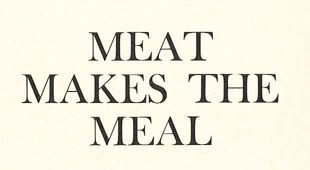
It had its own Cook Book.
But meat wasn't just limited to vast glistening centerpiece roasts. Meat could appear in many creative guises, such as Dilly Beef Cartwheel, Stuffed Pork Chops, Orange-Glazed Escarpments, Steak with Maggot Garnish (always serve with white zinfandel in an Erlenmeyer flask), Masked Identity Meat in Popovers, and Meatballs Attempting to Escape.
Meat dishes from this period can be roughly grouped into several categories: Meat that has been Ground and Shaped Into Masses, Meat that Maintains its Original Muscle Integrity, and Meat that Somebody Else has Already Processed. The variety of meatloaves and meatballs (meat loaves and meat balls, which sounds thirty times less appetizing) available in your standard Avocado Green and Harvest Gold kitchen would be categorized as Ground and Shaped Into Masses, as would leftover meat that has been chopped up and added to a jellied salad or vinyl sauce. Roasts and most hams, chops, and steaks would fall under the Original Muscle Integrity category, at least until the housewife cut holes in them and started stuffing cubes of Velveeta and canned pineapple inside. Meat that Somebody Else has Already Processed covers sausage of all descriptions, Spam and its forlorn competitors (Mor, Treet, Prem, Temt, Bif, etc), and canned ham.
Luckily for everyone, I've got examples of all three!
We'll begin with Mock Pot Roast, which is frankly sad. "Everyone squint, and I'll turn down the lights, and maybe if you wish real hard it'll taste like pot roast instead of a giant lump of ground beef, oats, and bottled gravy coloring!" The caption states that this is a "stunning" meat loaf in a dish. I suppose you could place the whole thing inside a sack and swing it at people's heads to stun them. I suppose.
Then we have Duchess Meat Loaf Pie, which is creative because it's a meat loaf in a skillet with instant mash on top and because it comes pre-infested with maggots.
The cook who is using ground meat may find herself faced with the difficult decision of whether to shape the flesh into a loaf or a ring. (Or a cube, or a cone, or a cowpat?) If she chooses the ring, she must fill the hole in the middle with enough green-flecked rice to support a selection of gleaming black shuttlecocks. If the loaf is selected, it must be topped with a miniature limp green octopus. Note the recipe for the "Piquant Ring" contains half a cup firmly packed brown sugar and a quarter-cup each of orange juice and molasses. Dentists must have loved the 70s.
Here we have semiconscious cow heads adorning round hamburgers and vinyl sauce (vinyl cheese, in this case) covering Wendy's-style square burgers. Note the use of what appear to be surgical pins to anchor the olives and tomatoes to the vinyl cheese.
Sometimes the housewife wanted to hide her shame and wrap up the ground meat inside a cabbage leaf. This never ended well.
Maggots are a recurring theme in the Great Book of Hamburger, as evidenced by Spanish Mince and Maggot Roll. Can you spot the worm head in this picture?
But nothing compares to this presentation: none of these ground-up gustatory delights can hold a candle to the following image:
Rapier-Pierced Bowel Movements in Ill-Fitting Buns.
That's quite enough of that. Let's move on to Meat that Retains its Original Muscle Integrity, with Sugared Pork Snout Roast. Doesn't that look amazing? Spiced pears, even!
Braising in bleach was one of the ways cooks in the 70s made sure their meals were free of illness-causing bacteria.
Here we have the fabled Death Valley Dead Thing Rôti. This must be cooked over a pale flame on rippled sand just as the sun peeps above a distant mountain range. Otherwise the skinwalkers will find you.
You think I'm kidding about the vinyl sauce thing? They came right out and said it: this unappealing pot roast is draped in a rich brown gravy. You don't drape gravy. You drape vinyl.
We've seen this before, but here's the pink petal posy ham à la sandworm head. Glazing of pig products with various viscous sugary syrups seems to have been not so much a fashion as an enforceable law: some creative individuals took advantage of the opportunity to glue things onto the side of their glazed pig chunks in the process of covering them in sugar. Somewhere out there on the internet there is a picture of a leg of something with a paddleboat design stuck onto it, made out of wheels of lemon. More about sugar and pig in future posts.
What of the third group, the Pre-Processed Meats? Well, the Meat Cook Book is diligent in explaining the various sorts of sausage known to man.
As many of you already know, the frankfurter was given a more classy and haute-cuisine sort of role in the sixties and seventies. Phrases like "frankfurter spectacular" and "Franks take on a new glamor in this gleaming aspic" now strike dread into the heart of the reader, but at the time we must imagine they were really considered to be more than just mechanically separated meat slurry spiked with nitrates. Take for example Frank Corn Crown, described as "fancy," or Glazed Apples 'n Franks. Gleaming, is what those are. Gleaming with sugar and preservatives.
Sausage could be possessive. You didn't want to get between a loop of kielbasa and its mustard pot.
Sometimes sausages were relegated to the role of garnish, but even so they were carefully prepared for their close-ups, some being given a golden spray tan and some remaining pallid and delicate grey-pink.
Sausage could also be brown.
And finally, pathetically, we come to Tangy Potato Salad, which consists of chunks of hot dog and potato mixed up with cream of celery soup. This, like several of the other dishes in today's post, is from the Better Homes and Gardens "Good Food on a Budget" cookbook, which offers the struggling housewife a variety of tips for "stretching" the food budget, including the use of variety meats and sating the heartier appetites with bread. "Good Food on a Budget" is less lurid and hallucinogenic than some of the earlier BHaG tomes, but it's a lot more depressing.
So have a Bacon Big Boy to cheer you up, and remember: MEAT MAKES THE MEAL.
I'm not making this up.
Thursday, May 20, 2010
You'll Love to Serve Viscera the Modern Way
For instance, if you've ever wondered how to stuff a heart, you need wonder no longer. Stuffing hearts isn't, of course, the only way to serve exciting variety meats:
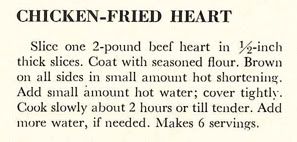
...for a down-home twang, or
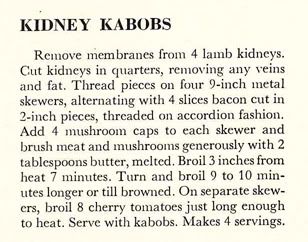
for that Middle Eastern flair. But remember,
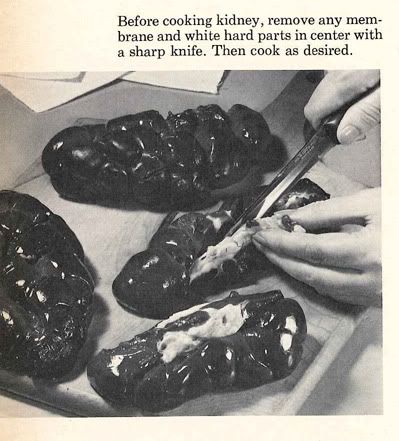
Those are of course beef kidneys in the above picture, which are supposed to look like giant glistening bowel movements. As of course you're well aware.
Now that we've got that out of the way, let's get on to HAM.
Everybody's favorite Spam precursor comes in many shapes. Here it is in sculptural waveforms; in petrified slab form; in glistening glucose-glazed slab form; in wet and green-tufted form, or in pink-petal-posied sandworm head form.
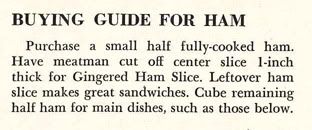
HAM.
You may possibly be wondering what the green substance is that's protruding from one of the above examples of HAM. It is in fact combined spinach, green onions, and parsley "tucked into deep cuts in meat." If that doesn't get your motor running, I can reassure you that like every other ham recipe in the universe of these books, it also contains enough sugar to give a whole cheerleading squad diabetes. I don't know why ham must be sweet: it should not be sweet, just as all other forms of meat should not be sweet. Would you put chocolate pudding on your steak? Then don't put honey on your ham, you wretched philistines.
To return to HAM, it is found in the wild in many shapes, before Better Homes & Gardens have got their psychedelic hands on it and drenched it in corn syrup: there is cylindrical, oviform, and pig-leg-shaped ham to be found, as well as rectangular, laminar, or long-barrow-shaped ham.
These hams have been sat on. Notice that the one in the middle apparently features a navel.
I trust this provides a thorough and well-balanced view of the world of ham, and close this episode of Non-Euclidean Food with the following image. I'm not telling you what this is: you will probably be able to locate it elsewhere on the web, but for now let it remain mercifully unidentified. This is from a cookbook published by a well-known and respectable family-oriented magazine.
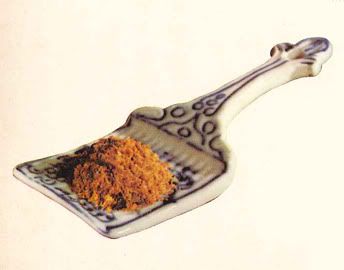
Wednesday, May 19, 2010
Why Art Directors and LSD Do Not Mix
I present to you Microwave Miracles from Sears, circa 1981. There aren't any pictures of the actual miraculous microwave, but it's a pretty safe bet to imagine something the size of an industrial transformer in tasteful shades of black and brown wood-grain. (I have to admit, here, that I own a 1986 JC Penney microwave/convection oven which is still going strong, despite being old enough to buy its own booze. Microwave magnetrons don't really wear out.)
Apparently one of the things 1981 Sears microwave ovens did was to make everything very brightly colored, and to accent this brilliance the book's designer called in the full force of the Inexplicable Props. For example, Eye of Sauron Pea Soup is accompanied by giant salt-and-pepper shakers designed to resemble faceless banisters carved of jade, and posed against a backdrop of floating lime-green mushrooms. Monolith of Meat is posed with a disturbingly tiny stemmed dish of what is presumably either horseradish or whipped lard, and watched over by a distant, silent, silver cow-god idol.
Kebabs on Bleached Rice, accompanied by Banana Slugs in Spinach, are watched over by a pair of onion-shaped albino alien beings. Also note the cutlery handles, which appear to be ceramic puffins that have been stretched longitudinally. Stir-fried Worms are also guarded by two white aliens, cleverly disguised as little pottery pagodas, and served in an orange-red limbo in front of openwork screens designed to throw the shadow of the Cross on all they survey.
More unpleasantly, Jellied Emesis--also on bleached rice--is served with your choice of shredded coconut, yellow lima beans, or something brown and sticky which could be a chutney of some kind, and posed with a couple of artifacts stolen from the Vaguely Moroccan Or Something wing of the local museum. But none of these are quite as inexplicable as Turkey with Vinyl Sauce served as an offering to a miniature cast-iron coal-fired range. It's an adorable if somewhat disturbing miniature cast-iron coal-fired range and I want it (it comes with pans! And a coal-scuttle!), but what it has to do with bland slices of turkey breast served with broccoli I cannot fathom. I think at this point the art director was giggling madly and grabbing for any object he or she could find to pose with dishes. Dollhouse appliances? Great! Laboratory glassware? Bring it on! Dollar-store kitch? Beautiful!
Moving on, we come to Dismembered Fish stuffed with stuff and topped with bacon, accompanied with whipped lard and rabbit droppings, and posed with dead grass and a wood-and-metal fish sculpture gazing in frozen horror at something offcamera to the left. Note that the fish sculpture, unlike the fish entrée, still has its head attached.
Next up is Glistening Almond-Strewn Tripe, apparently served on the Mary Celeste. Technically this dish is "Filet of Sole Almondine," but I've also been advised that it could be a casserole full of Vinyl Sauce Puddles as seen on the turkey served with dollhouse kitchen appliances. Just arrange your foodstuffs on a plate and drape one of these over it and bang, you have a real classy presentation. See, for example, Mount St. Cholesterol, balanced atop eggs in a carton and regarded with disdain by a blue cock. The substance drizzled over this dish could easily be taken from the casserole-of-vinyl-glop.
In the 1980s, any decent housewife would take pride in her culinary skill and in the style with which she served guests and family. Crocheted Spaghetti is one of those dishes by which you can measure a chef's capability; the strands of albino pasta had to be woven just so on the serving fork, echoed in place settings by the melted Chianti bottles stuffed with broomstraw. If you got the pattern of pasta on your fork wrong, the whole neighborhood would know you weren't a good wife and mother.
Desserts were important too. Brownie with Melted Crayon, Yellow-Flavored Yellow Cake with Yellow Filling, and Baked Insulation topped with Whipped Cream had to be watched over by a belligerent pewter swan; really classy cooks would garnish the swan with plastic roses in a hue exactly matching the desserts.
Sometimes you had to serve meals outdoors against a weathered shingle wall, and when this was the case your standard beige vinyl sauce wasn't up to the task of presentation: you had to slather stage blood atop the vinyl sauce if you wanted your Pan-Fried Insoles to look their best. Serve with iced tea in a volumetric flask and breaded rebar pieces in a decorative bucket.
Finally, we come to Glistening Stew. The secret ingredient in this recipe is multiple coatings of polyurethane varnish. A properly prepared Glistening Stew will not move even if the pot is turned upside down and shaken. This example is served with salt and pepper shakers in an elegant blue-pattern porcelain, but the really interesting aspect of the presentation is the porcelain plate behind the stew pot, which appears to be staring in abject horror at the dish. Get me out of here, it's begging. For the love of God.
This concludes today's edition of Inexplicable Props and Yellow Glop. Stay tuned for Ways with Ham.
Tuesday, May 18, 2010
What went horrifically wrong
My local Goodwill, quite apart from supplying me with designer clothes at ludicrously low prices, is a ready source of Awful Retro Cookbooks. Some of these are pretty staid and uninteresting (put glop in pan, add cream-of soup, bake) and some of them are the product of a diseased mind.
Let's play "Identify the Foodstuff."
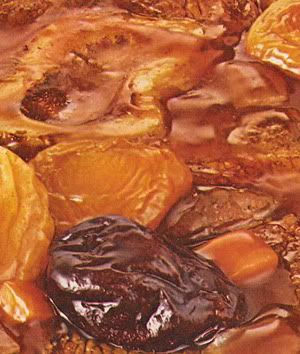
Gulf oil spill, lava, liposuction products? Assuming this is meant to be edible, is the substrate a bread, or cake, or vegetable, or meat?
It's fruity.
How about this:
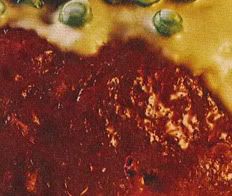
Really bad frog sculpture or microscopic shot of Staph aureus? I'd go for the latter.
It's ever-fancy.
Or this:
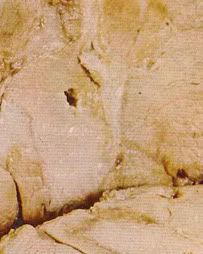
A friend of mine had hoped that this was bread. It's not. It's flavorful.
Some of these are from the Better Homes & Gardens Creative Cooking Library Best Buffets book. I don't know how much of this can be chalked up to the fact that people in the 70s apparently had limited perception of colors--perhaps some of these dishes might look less terrifying if they weren't so luridly oversaturated--but I think this is evidence that Batman villains were running the BH&G show. This gem also offers us Meat Balls with French Cream, an obvious attempt to encourage consumption of horse dung, Split Wieners and Impaled Cartoon Eyeballs under the stern glare of a pair of sentinel salt-and-pepper shakers, and whatever the hell this is. I'm particularly taken with the continued horse-dung theme in the pan of conjoined bread rolls at the top, which also suggests frog eggs. You see what I mean about color.
Also, it's nice that the Best Buffets authors took men's unique needs into consideration with a Bachelors' Feast featuring Deviled Bones and Neiman-Marcus Apple Pie, but I have to wonder about this guy, who is clearly dismembering a corpse. He's just jacked Mr. Rogers' cardigan, too. Not the type of Bachelor a woman really wants.
I leave you with the image of strife-torn Bolivia, this week on Storage Jars.
